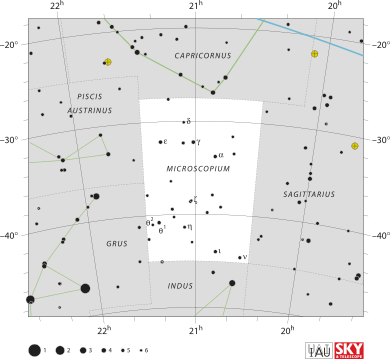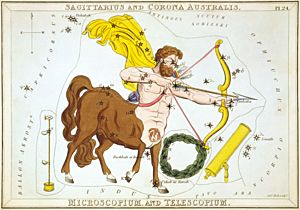Microscopium (constellation) facts for kids
| Constellation | |

List of stars in Microscopium
|
|
| Abbreviation | Mic |
|---|---|
| Genitive | Microscopii |
| Pronunciation | genitive |
| Symbolism | the Microscope |
| Right ascension | 21 |
| Declination | −36 |
| Quadrant | SQ4 |
| Area | 210 sq. deg. (66th) |
| Main stars | 5 |
| Bayer/Flamsteed stars |
13 |
| Stars with planets | 2 |
| Stars brighter than 3.00m | 0 |
| Stars within 10.00 pc (32.62 ly) | 2 |
| Brightest star | γ Mic (4.67m) |
| Messier objects | none |
| Meteor showers | ????? ????? |
| Bordering constellations |
Capricornus Sagittarius Telescopium (corner) Indus Grus Piscis Austrinus |
| Visible at latitudes between +45° and −90°. Best visible at 21:00 (9 p.m.) during the month of September. |
|
Microscopium is a small constellation found in the southern sky. Its name comes from a Latin word. It means "the microscope." This constellation is not very bright. You might need a dark sky to see it clearly. It looks like a small, faint group of stars.
Contents
About Microscopium
Microscopium is one of the 88 modern constellations. It is a newer constellation. It was not known to ancient people. It is part of a group of constellations. These are called the La Caille Family. They are named after scientific tools.
Where is Microscopium Located?
Microscopium is in the fourth quadrant of the southern sky. This means it is in the southeast part of the sky. It is next to several other constellations. These include Capricornus, Sagittarius, and Piscis Austrinus. It is best seen in the month of September. People in the Northern Hemisphere cannot see it. You need to be south of the 45th parallel north.
How Microscopium Got Its Name
Many constellations have names from ancient myths. Microscopium is different. It was named after a scientific tool. This shows how science was growing.
Who Named Microscopium?
A French astronomer named Nicolas-Louis de Lacaille created Microscopium. He lived in the 1700s. He spent time at the Cape of Good Hope. This is in South Africa. From there, he mapped the southern sky. He named 14 new constellations. Many of them were scientific instruments.
Why a Microscope?
Lacaille named Microscopium after the microscope. This tool helps us see tiny things. It was an important invention. It helped scientists learn about the world. By naming a constellation after it, Lacaille honored science. He also named other constellations after tools. These include the Telescope and the Compass.
Stars of Microscopium
Microscopium is not famous for very bright stars. Most of its stars are faint. You might need binoculars to see them well.
Brightest Stars in Microscopium
The brightest star in Microscopium is called Gamma Microscopii (γ Mic). It is a giant star. It is much bigger than our Sun. It shines with a yellow-orange light. Gamma Microscopii is about 380 light-years away from Earth.
Another interesting star is Lacaille 8760. This star is much closer to us. It is only about 12.87 light-years away. It is a red dwarf star. Red dwarfs are small and cool. They are the most common type of star in our galaxy.
Stars with Planets
Even though Microscopium is faint, some of its stars have planets. Astronomers have found exoplanets orbiting stars in this constellation. This means there are other worlds out there. They are orbiting stars far away from our Sun. Finding these planets helps us learn more about the universe. It also helps us understand how planets form.
Images for kids
See also
 In Spanish: Microscopium para niños
In Spanish: Microscopium para niños



